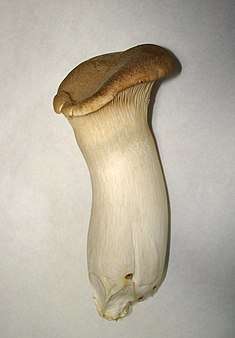Pleurotus eryngii
Pleurotus eryngii (also known as king trumpet mushroom, French horn mushroom, king oyster mushroom, king brown mushroom, boletus of the steppes,[Note 1] trumpet royale, aliʻi oyster) is an edible mushroom native to Mediterranean regions of Europe, the Middle East, and North Africa, but also grown in many parts of Asia.[1]
| Pleurotus eryngii | |
|---|---|
 | |
| Pleurotus eryngii | |
| Scientific classification | |
| Kingdom: | |
| Phylum: | |
| Class: | |
| Order: | |
| Family: | |
| Genus: | |
| Species: | P. eryngii |
| Binomial name | |
| Pleurotus eryngii (DC.) Quél. 1872 | |
| Pleurotus eryngii | |
|---|---|
float | |
| gills on hymenium | |
| cap is depressed or offset | |
| hymenium is decurrent | |
| stipe is bare | |
| spore print is white | |
| ecology is saprotrophic | |
| edibility: choice | |
Description
P. eryngii is the largest species in the oyster mushroom genus, Pleurotus, which also contains the oyster mushroom Pleurotus ostreatus. It has a thick, meaty white stem and a small tan cap (in young specimens). Its natural range extends from the Atlantic Ocean through the Mediterranean Basin and Central Europe into Western Asia and India.[2] Unlike other species of Pleurotus, which are primarily wood-decay fungi, the P. eryngii complex are also weak parasites on the roots of herbaceous plants, although they may also be cultured on organic wastes.[2][3]
Taxonomy
Its species name is derived from the fact that it grows in association with the roots of Eryngium campestre or other Eryngium plants (English names: 'sea holly' or 'eryngo'). P. eryngii is a species complex, and a number of varieties have been described, with differing plant associates in the carrot family (Apiaceae).
- P. eryngii var. eryngii (DC.) Quél 1872 – associated with Eryngium ssp.
- P. eryngii var. ferulae (Lanzi) Sacc. 1887 – associated with Ferula communis[4]
- P. eryngii var. tingitanus Lewinsohn 2002 – associated with Ferula tingitana[4]
- P. eryngii var. elaeoselini Venturella, Zervakis & La Rocca 2000 – associated with Elaeoselinum asclepium[5][6]
- P. eryngii var. thapsiae Venturella, Zervakis & Saitta 2002 – associated with Thapsia garganica[7]
Other specimens of P. eryngii have been reported in association with plants in the genera Ferulago, Cachrys, Laserpitium, and Diplotaenia.[2]
Molecular studies have shown Pleurotus nebrodensis to be closely related to, but distinct from, P. eryngii.[2] Pleurotus fossulatus may be another closely related species.[2]
Uses
The mushroom has a good shelf life and is cultivated widely. It has little flavor or aroma when raw. When cooked, it develops typical mushroom umami flavors with a texture similar to that of abalone.
Pleurotus eryngii may contain chemicals that stimulate the immune system.[8] Dietary intake of Pleurotus eryngii may function as cholesterol-lowering dietary agent.[9]
Like some other Pleurotus species, P. eryngii attacks nematodes and may provide a control method for these parasites when they infect cats and dogs.
See also
Notes
- The name "boletus of the steppes" is misleading as Pleurotus eryngii is a gilled mushroom in order Agaricales and Boletus is a genus of mushrooms with pores rather than gills in order Boletales.
References
- Archived May 18, 2006, at the Wayback Machine
- Zervakis, Georgios I.; Venturella, Giuseppe; Papadopoulou, Kalliopi (2001). "Genetic polymorphism and taxonomic infrastructure of the Pleurotus eryngii species-complex as determined by RAPD analysis, isozyme profiles and ecomorphological characters". Microbiology. 147 (11): 3183–3194. doi:10.1099/00221287-147-11-3183. PMID 11700370.
- Alma E. Rodriguez Estrada & Daniel J. Royse (February 2008). "Pleurotus eryngii and P. nebrodensis: from the wild to commercial production". Mushroom News. Archived from the original on 2014-06-10.
- Lewinsohn, D.; Wasser, S. P.; Reshetnikov, S. V.; Hadar, Y.; Nevo, E. (2002). "The Pleurotus eryngii species-complex in Israel: Distribution and morphological description of a New Taxon". Mycotaxon. 81: 51–67.
- Venturella, G.; Zervakis, G.; La Rocca, S. (2000). "Pleurotus eryngii var. elaeoselini var. nov. from Sicily". Mycotaxon. 76: 419–427.
- Alma E. Rodriguez Estrada; Maria del Mar Jimenez-Gasco & Daniel J. Royse (May–June 2010). "Pleurotus eryngii species complex: Sequence analysis and phylogeny based on partial EF1α and RPB2 genes". Fungal Biology. 114 (5–6): 421–428. doi:10.1016/j.funbio.2010.03.003. PMID 20943152.
- Venturella, G.; G. Zervakis & A. Saitta (2002). "Pleurotus eryngii var. thapsiae var. nov. from Sicily". Mycotaxon. 81: 69–74.
- Nozaki H, Itonori S, Sugita M, Nakamura K, Ohba K, Suzuki A, Kushi Y (Aug 2008), "Mushroom acidic glycosphingolipid induction of cytokine secretion from murine T cells and proliferation of NK1.1 alpha/beta TCR-double positive cells in vitro", Biochemical and Biophysical Research Communications, 373 (3): 435–9, doi:10.1016/j.bbrc.2008.06.047, PMID 18577373
- Alam, Nuhu; Yoon, Ki Nam; Lee, Jae Seong; Cho, Hae Jin; Shim, Mi Ja; Lee, Tae Soo (Oct 2011). "Dietary effect of Pleurotus eryngii on biochemical function and histology in hypercholesterolemic rats". Saudi Journal of Biological Sciences. 18 (4): 403–409. doi:10.1016/j.sjbs.2011.07.001. ISSN 1319-562X. PMC 3730794. PMID 23961153.
Sources
- Rudabe Ravash; Behrouz Shiran; Aziz-Allah Alavi; Fereshteh Bayat; Saeideh Rajaee & Georgios I. Zervakis (2009). "Genetic variability and molecular phylogeny of Pleurotus eryngii species-complex isolates from Iran, and notes on the systematics of Asiatic populations". Mycological Progress. 9 (2): 181–194. doi:10.1007/s11557-009-0624-2.